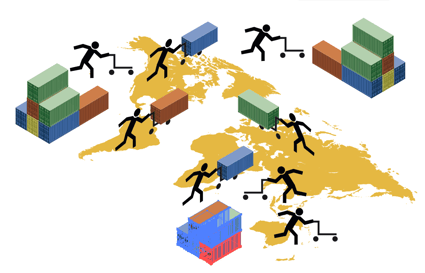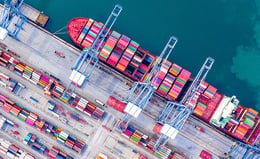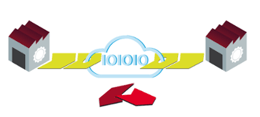Why the Future of Supply Chains Is Sustainable
Jesse Kelber - January 02, 2020

Sustainability is more than a buzzword. In a recent study reported in Forbes, a whopping 88% of those polled say they are more likely to support brands that they view as helping them lead more ethical and sustainable lives. What impact does this have on your supply chain? Well, the public is who ultimately buys your product, and they’ve spoken. They want companies to care as much as they do about leaving a better planet for the generations to come. As members of the global community, we need to step up and do what we can to support the goals laid out by nations the world over, to clean up sourcing, pollution, workforce conditions, and more. Just how to go about cleaning up an end-to-end supply chain is a complicated question, so here are some guidelines we hope will help set you on the right path.
Why The Future of Supply Chains Needs to Be Sustainable
Global consensus is that we’re heading for a serious climate-related disaster if we don’t step up and make some big changes, now. Along with that public opinion comes necessary changes in how business is done if you want to keep your customer base happy, let alone see it grow and flourish. Governments are already listening to the science and to their people. Regulations are being drawn up every day to reign in pollution, curb mistreatment of workers in developing nations, and clean up resource management issues. It will pay off in the short-term to make visible changes to how you do business today, to show that you care about the future to come.
This isn’t just a PR issue: sorting out your up-stream raw material sourcing now can bring big savings in increased efficiency down-stream. Raw material extraction practices that are easier on the environment are also easier on the workforce doing the extracting. And cleaning up these areas has been shown to elevate the standard of living for these populations as well. By partnering with ethical resource partners, you can start having an impact today. And that impact will not only improve the lives of the workers, you’ll see it in your reduced spending and improved ROI as the efficiencies follow the materials through the chain.
On top of the environmental and ethical impact of a clean and sustainable up-stream supply chain, you have to look at the final product and who your customers are. As they mature and become a bigger part of the global economy, this is increasingly Generation-Z. These post-millennials are the most values-driven generation in history, not shy about telling companies exactly why they won’t do business with them and sharing those reasons with their friends. They want to know not only the impact their new car will have on the environment after they buy it, but increasingly they want to be able to track the supply chain upstream as well. With global climate change already disrupting business (due in part to the supply chain’s reliance on raw materials from the regions most impacted), the best time to act is now to start making it clear to the upcoming generations that you are doing your part to make the world a little better for them.
How to Begin Cleaning Up Your Own Supply Chain
The single most crucial piece of the sustainability puzzle is visibility. How can you know the impact your raw material extraction is having on the population if you don’t know where it’s coming from and how it’s being collected? And how can you clean up emissions at your factories if you can’t see which machinery is the culprit behind the pollution? This extends to transparency for your customers as well, as the easier it is for them to see your sustainability efforts, the more likely they are to champion your brand. Complete visibility is, of course, the end goal. But every step you can take to gain open up not only your own processes but those of your up- and down-stream partners is a step in the right direction.
Start with Industry 4.0 technology like IoT sensors on your factory floor, then move on to integrating systems with your partners. Those sensors can provide you with the predictive analytics you need to ensure your equipment is running at peak efficiency, both in terms of production and emissions. GPS tracking on your shipments can allow you to better allocate resources and shipment segments, creating less dead space during transport and lowering both costs and emissions in the process. Finally, deploying a robust supply chain management solution will give you the basis on which you can integrate with your partners for insight into their systems and how clean their processes are.
On the far up-stream end, the critical step will be to build your resource hub on sustainable practices. When looking to create change over the length of a supply chain, it’s key to start at the beginning. By selecting eco- and labor-friendly suppliers with proven track records you will not only start with clean raw materials, but also a clean conscious. And remember to publicize these changes so your audience will see the steps you’re taking and count you among the “good guys.” The impact this good PR can have will be long lasting, as people tend to develop long-term relationships with companies whose mission and values they support.
Emissions: You Can’t Reduce What You Don’t Measure
The next piece to the sustainability puzzle is being able to track emissions and integrate this information into your optimization calculations. The key idea here is to know your carbon footprint. Some modern supply chain management solutions include a module that can assist in calculating your real-time emission levels, allowing you to optimize your emissions in conjunction with other metrics like fuel use and transport efficiency. Greenhouse gas emissions from the supply chain account for the majority of emissions worldwide, often representing up to 4x the emissions from the everyday operations of a company.
When combined with the second largest contributor (transportation and logistics), these sources of greenhouse gas emissions provide a large target for any company to work toward reducing. Of course, you can’t reduce what you don’t measure. IoT enabled emissions sensors are the first step, feeding real-time data into advanced analytics engines to calculate where your carbon is coming from so you can develop targeted programs aimed at reducing both your carbon footprint and the associated costs. Remember, sustainability is good for the environment as well as your bottom line, since a cleaner company will be easier to maintain and grow as we move deeper into an uncertain climate future.
LATEST POSTS
- Understand Circular Economy in The Manufacturing Industry
- How Can Industry 4.0 IT Integration Be Achieved Smoothly?
- The Significance of Order Sequencing in Discrete Manufacturing
- How to improve your Supply Chain Management: The Power of Control Towers
- Optimizing Human Resource Scheduling in Manufacturing: A Technological Approach



